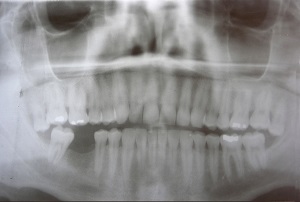
by fisherwebdesign | Jun 29, 2016 | Blog, Endodontics, Phoenix Endodontic Group, Root Canal, Technology
 Endodontics became a specialty in the early 1960s, but dentists have been performing root canal procedures on patients since the 1800s. Thankfully, the world of root canals has come a long way since the turn of the 19th century.
Endodontics became a specialty in the early 1960s, but dentists have been performing root canal procedures on patients since the 1800s. Thankfully, the world of root canals has come a long way since the turn of the 19th century.
Implementing a root canal has gotten much easier, and the overall outcome of the procedure itself has improved since the introduction of nickel-titanium files. These files were first introduced in the late 1980s and are made of a unique alloy that is extremely flexible, which helps to preserve the original anatomy of the root canal. This, in turn, results in better efficiency, predictability, and improved clinical results of endodontic treatment, especially in significantly curved canals.
Digital radiography is another handy tool that we use as endodontists. Originally introduced in the 1990s, it has certainly revolutionized the field of endodontics, as well as the entire dental community, by allowing the dentist to manipulate an image and provide a much higher overall diagnostic quality. Thankfully, it does this with much less radiation than was needed to capture a standard radiographic dental film in the past.
In addition to digital radiography, the operating microscope is relatively new in the endodontic world. Magnification and fiber optic illumination are helpful in aiding the endodontist by allowing him or her to see very small details inside the teeth that that need work. Also, a tiny video camera on the operating microscope can record images of a patient’s tooth to further document the doctor’s findings.
Finally, three-dimensional radiographs (cone-beam commuted tomography) allows endodontists to help diagnose potential issues more accurately and provide treatment with unprecedented confidence. Unlike a traditional spiral CT scanner, this 3D system provides precise, crystal-clear digital images while minimizing the patient’s exposure to radiation. This system allows for unmatched visualization of anatomical detail, which aids in diagnosis, treatment planning, and the actual root canal treatment. Your doctors can use this innovative technology to quickly and easily share 3D images of the area of concern with your referring doctor, giving them an opportunity to collaborate on your care, improve your experience, and deliver a positive treatment outcome.
Although there are many other advancements in endodontics on the horizon (stem-cell regeneration of the root canal system, as well as reconstructing the teeth themselves), the current ones allow for much better diagnosis, treatment planning, and pain-free root canals than ever before.

by Dr. Jacqueline S. Allen | Jun 28, 2016 | Blog, Endodontics, Patients, Phoenix Endodontic Group
 Phoenix Endodontic Group has been using an online patient referral system since 2005. That’s right – for the last 11 years, we have offered our referring dentists the ease and convenience of online referrals and case management for patients sent to our office for endodontic treatment.
Phoenix Endodontic Group has been using an online patient referral system since 2005. That’s right – for the last 11 years, we have offered our referring dentists the ease and convenience of online referrals and case management for patients sent to our office for endodontic treatment.
Back in 2005, online referrals were a difficult concept for Phoenix dentists to come around to. The old pen-and-paper method worked just fine before, but the explosive use of technology, along with tighter HIPPA requirements has made utilizing an online referral system a “must” for dental offices in Phoenix. “The rest of the world has finally caught up with our capabilities,” said Kevin G. Conroy, Operations Manager at Phoenix Endodontic Group.
Simply put, from the start of the referral process to the end, when a final report is generated, Phoenix Endodontic Group’s TDO software handles the communication between offices seamlessly. The referring office has its unique sign in to a HIPPA Compliant web portal to exchange patient information directly with our office. There is no need for secure emails because no patient information is sent via email.
Enhancements to this system are ongoing, and there are many benefits for the Phoenix dentist office that uses our referral system:
- Saves time — a referral can be made before the patient leaves the general dentist’s office – there are no hold time or delays.
- Convenience — no more looking for paper referral slips, which sometimes get misplaced by patients prior to making an appointment.
- Accuracy — not all doctors have the best handwriting, so typing in the specifics of a referred case makes misinterpretation less likely.
- HIPPA Compliant — using online referrals eliminates the risk of a potential privacy violation.
The 21st century has changed the way we all conduct business. At Phoenix Endodontic Group, we are always interested in utilizing best practices for our referring offices and patients alike.

by Dr. Jacqueline S. Allen | Apr 18, 2016 | Blog, Business, Endodontics, Endodontist, Phoenix Endodontic Group
 The entire team at Phoenix Endodontic Group has a keen awareness that we are here to provide gentle and individualized care to all patients entrusted to us by our referring doctors or that have sought us out on their own. There are many endodontic specialists in the Valley, and we realize that we must always “be at our best” relative to patient care.
The entire team at Phoenix Endodontic Group has a keen awareness that we are here to provide gentle and individualized care to all patients entrusted to us by our referring doctors or that have sought us out on their own. There are many endodontic specialists in the Valley, and we realize that we must always “be at our best” relative to patient care.
Understanding what patients are seeking when they come to our office helps us be able to define what sets us apart from other endodontic specialists.
- Patients want to be treated with the state of the art equipment – Phoenix Endodontic Group consistently makes investments in technology and training to be able to deliver the best in modern endodontic therapy to our patients.
- Patients want their endodontist to listen to their concerns and fully answer their questions relative to treatment options – Phoenix Endodontic Group is the only endodontic practice in the Phoenix/Paradise Valley area with all-female practitioners. Dr. Jacqueline Allen and I have many years of experience and training treating patients with endodontic pain. We take our time with consultations and develop a treatment plan with the patients best interests in mind.
- Patients need access to care when they are experiencing pain and discomfort. No one can predict when the need for a root canal will arise. Phoenix Endodontic Group has two conveniently located offices that are open Monday – Friday from 7:00am – 5:00pm on most days.
At Phoenix Endodontic Group we live by a simple rule – Treat our patients the way we wish to be treated when we receive care. Living by this rule has help to make us one of the top endodontic specialty offices in the Phoenix/Paradise Valley area.

by Dr. Jacqueline S. Allen | Feb 2, 2016 | Blog, Endodontist, Phoenix Endodontic Group
 Endodontics is one of nine specialties recognized by the American Dental Association, so it’s not surprising that Phoenix endodontists get many of their patients from referrals from general dentists. According to the American Association of Endodontists, 97 percent of general dentists referred a patient to an endodontist last year.
Endodontics is one of nine specialties recognized by the American Dental Association, so it’s not surprising that Phoenix endodontists get many of their patients from referrals from general dentists. According to the American Association of Endodontists, 97 percent of general dentists referred a patient to an endodontist last year.
There are several reasons endodontic referrals are made, all of which result in a better outcome for you and your teeth.
Why Phoenix endodontists receive referrals
- Experience and training – Endodontists receive two to three years of postgraduate training in this special practice area, which relates to treating the diseases of the inner dental pulp and nerves. They also typically do many more root canals than general dentists do – as many as 25 per week, versus a general dentist, who may average two root canals a week.
- Equipment – Root canals are performed with specialized equipment that includes microscopes with which to view the surgery area and files to clean out the infected canals.
- Ability to treat complex or unusual cases – Many patients who are referred to an endodontist have tooth roots that may be curved, have multiple roots for one tooth, or have other anomalies. Endodontists rely on their additional training and expertise to guide them through successful treatment of these unique cases.
- Ability to make the treatment comfortable – Endodontists can often perform root canals and other related procedures more quickly than general practitioners, which can result in greater comfort and reduced anxiety for a patient.
“Your Phoenix endodontist has close professional relationships with many general dentists in the Valley,” says Dr. Allen, who practices with the Phoenix Endodontic Group. “We are able to provide fast, efficient, successful treatments within our area of practice, so general practitioners may focus on providing other services.”

by Dr. Jacqueline S. Allen | Jan 27, 2016 | Blog, Endodontist, Phoenix Endodontic Group
 One of the most traumatic dental injuries a person can experience is having a permanent (“adult”) tooth knocked out. Many knocked-out teeth happen as a result of sports injuries or other accidental blows to the face. The good news is that if proper steps are followed immediately after the tooth is dislodged, it is possible for your Phoenix endodontist to help you save the tooth.
One of the most traumatic dental injuries a person can experience is having a permanent (“adult”) tooth knocked out. Many knocked-out teeth happen as a result of sports injuries or other accidental blows to the face. The good news is that if proper steps are followed immediately after the tooth is dislodged, it is possible for your Phoenix endodontist to help you save the tooth.
Saving Your Knocked-Out Tooth
- Pick up the tooth by the crown, not the root. It’s essential for the tooth’s survival that you pick up the tooth by the biting surface, not the root.
- Gently clean the tooth if it is dirty … but be careful how you do it. Gently clean the tooth with water. It’s important not to clean the tooth with soap or chemicals, to scrub the knocked-out tooth, or to wipe it with or wrap it in a cloth.
- Keep the tooth moist at all times. The best ways to keep the tooth moist after cleaning it are to keep it in milk, in the contents of an emergency tooth preservation kit such as Save-A-Tooth, or to place it back inside of your mouth.
- Reposition the tooth in its socket if that is possible. The sooner the tooth is replaced, the greater the likelihood it will survive. If you can get the tooth to sit in its socket, hold the tooth in place with fingers or by gently biting down on it.
- See your Phoenix endodontist immediately. Time is of the essence with a knocked-out tooth. The first hour is crucial. If you can get to a Phoenix endodontist within the first 20 minutes for emergency treatment, that’s even better.
Once you arrive at your Phoenix endodontist, he or she will splint the tooth in place and evaluate its condition. The splint may stay in place for up to several weeks. Because the tooth has been knocked out by its roots, he or she may recommend root canal treatment to avoid infection and provide long-term stability for the tooth.
“Don’t assume that if your tooth has been knocked out, it can’t be saved,” says Dr. Allen, who practices with the Phoenix Endodontic Group. “Your Phoenix endodontist can often save your tooth, and it can remain in your mouth for a lifetime.”

by Dr. Jacqueline S. Allen | Dec 7, 2015 | Blog, Endodontics, Phoenix Endodontic Group, Root Canal
 When a full-blown toothache happens, it can seem almost impossible to ignore. But sometimes it can be unclear what is happening, or what to do next.
When a full-blown toothache happens, it can seem almost impossible to ignore. But sometimes it can be unclear what is happening, or what to do next.
An infection in your tooth root that has abscessed is a serious matter. Here are a few facts about abscessed teeth that can help you make the right decision for your health quickly and get the treatment, including a root canal, that you may need.
What happens when a tooth becomes abscessed
A tooth abscess happens when there is an infection in or around the root of the tooth. Infection can enter a tooth due to decay, a crack or a chip in the tooth, or when periodontal (gum) disease becomes advanced and the infection enters through a pocket (gap) between the tooth and the surrounding gums. When there is an abscess, the pulp inside of a tooth dies and may become inflamed.
Symptoms of a tooth abscess
Often patients with a tooth abscess will feel an ache in the bone around the tooth. This may start as a throbbing pain that won’t go away. Sensitivity in the tooth to heat and when chewing may also be present. Later, a fever may develop, or lymph nodes under the jaw or in the neck may swell and become tender. If the abscess breaks open, a sudden rush of foul-smelling and foul-tasting fluid (pus) may spill into the mouth.
After acute pain passes and the diseased pulpal tissue dies, the pain may fade, or even go away, but the problem won’t.
Treating an abscessed tooth
A dental specialist such as an endodontist should evaluate a tooth that may be abscessed. They will take a detailed history of the pain symptoms, test the responsiveness of the tooth to temperature and pressure, and evaluate radiographs (x-ray pictures) in order to help make a diagnosis.
It’s important to determine the origin of the infection. If the infection is inside the tooth’s pulp, a root canal treatment, with an appropriate restoration applied afterward, can ensure the infection doesn’t return. If it is a serious periodontal infection causing the abscess, the gums also will need to receive treatment to prevent the spread of the infection.
“Always take toothache symptoms seriously,” says Dr. Allen, an endodontist with the Phoenix Endodontic Group. “Get a professional evaluation. If it is being caused by an abscessed tooth, a root canal treatment can often save the tooth and keep it healthy for years to come.”

 Endodontics became a specialty in the early 1960s, but dentists have been performing root canal procedures on patients since the 1800s. Thankfully, the world of root canals has come a long way since the turn of the 19th century.
Endodontics became a specialty in the early 1960s, but dentists have been performing root canal procedures on patients since the 1800s. Thankfully, the world of root canals has come a long way since the turn of the 19th century.

 Phoenix Endodontic Group has been using an online patient referral system since 2005. That’s right – for the last 11 years, we have offered our referring dentists the ease and convenience of online referrals and case management for patients sent to our office for endodontic treatment.
Phoenix Endodontic Group has been using an online patient referral system since 2005. That’s right – for the last 11 years, we have offered our referring dentists the ease and convenience of online referrals and case management for patients sent to our office for endodontic treatment.

 Endodontics is one of nine specialties recognized by the American Dental Association, so it’s not surprising that Phoenix endodontists get many of their patients from referrals from general dentists. According to the American Association of Endodontists, 97 percent of general dentists referred a patient to an endodontist last year.
Endodontics is one of nine specialties recognized by the American Dental Association, so it’s not surprising that Phoenix endodontists get many of their patients from referrals from general dentists. According to the American Association of Endodontists, 97 percent of general dentists referred a patient to an endodontist last year.
 One of the most traumatic dental injuries a person can experience is having a permanent (“adult”) tooth knocked out. Many knocked-out teeth happen as a result of sports injuries or other accidental blows to the face. The good news is that if proper steps are followed immediately after the tooth is dislodged, it is possible for your Phoenix endodontist to help you save the tooth.
One of the most traumatic dental injuries a person can experience is having a permanent (“adult”) tooth knocked out. Many knocked-out teeth happen as a result of sports injuries or other accidental blows to the face. The good news is that if proper steps are followed immediately after the tooth is dislodged, it is possible for your Phoenix endodontist to help you save the tooth.
